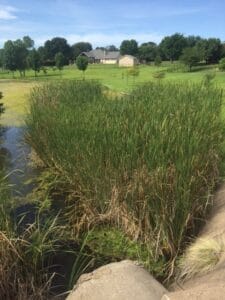Cattails are one of the most common invasive plants found in urban ponds. Whether to control or ignore their growth ultimately depends on the goals of the pond owner. However, neglecting the growth completely can be detrimental to a pond. At a minimum, their growth should be kept in check by treating selected areas with EPA approved aquatic herbicides. Highly neglected ponds may require 2 or 3 treatments per growing season over two consecutive years to completely eradicate cattail growth.

Dormant Cattails Surrounding Pond
Unlike most plants, cattails have roots or “rhizomes” that grow laterally. These rhizomes create an extensive network that can quickly surround a pond. The rhizomes produce hundreds of young cattail shoots which elongate and produce seed heads by mid-summer. Cattails can reach 10 feet tall by the time the seed heads are produced. The seed heads eventually rupture and the seeds are dispersed by wind action. This spreads more cattails to other portions of the pond, or even to a neighboring body of water. In the winter, the cattails go dormant and the shoots turn brown, fall over, and decay. The growth process starts over the following spring.
The pros and cons of cattail growth are given below. These should be used by pond owners to help determine a stance on cattails and decide whether or not they should be controlled. We always recommend at least some control measures be taken. We have seen numerous instances where a pond owner initially wants to keep the cattails; sometimes deliberately planting them in a new pond. They eventually realize their mistake a year or two down the road. Allowing uncontrolled growth significantly increases the long term costs associated with pond management. Therefore, it is best to decide sooner rather than later.
Pros of Cattails:
- The extensive vegetative growth network is good for filtering heavy runoff. The base of the cattails catch trash and filter excess nutrients which would otherwise end up in the pond; fueling the out of control growth of algae.
- The rhizomes of the cattails are good for stabilizing soil. They can help minimize bank erosion on steep or wind swept shorelines. Likewise, moderate cattail stands in the upper end of retention ponds slow down heavy storm-water velocities and reduce the risk of erosion.
- Cattails provide nesting and breeding habitat for a variety of desirable wildlife, most notably red-winged blackbirds and migratory ducks.
- Cattails are commonly used as cover and feeding areas for popular gamefish such as largemouth bass, crappie, and various sunfish species. In ponds where angling is a top priority, fishermen can often increase catch rates by targeting those areas in and around cattail stands.
Cons of Cattail Growth:
- Cattails grow vigorously and the resulting biomass can eventually block out the growth of more desirable and less invasive plant species.
- Cattail growth can obstruct critical elements of a pond. These include drain structures, emergency spillways, auto-fills, and irrigation intakes. Blocking of drain structures and spillways increases the risk of flooding. In fact, many municipalities require that communities eliminate any cattails growing above, on, or below spillways.
- The annual reproductive, growth, and decay cycle accelerates eutrophication (aging) of the pond. Eutrophication causes the buildup of organic sludge on the pond bottom and encourages the growth of algae and noxious aquatic vegetation. All of this leads to accelerated siltation and creates the need for costly dredging.
- Excessive cattails block access to the pond and can interfere with recreational uses such as angling and boating. Unmanaged cattails can surround a pond and also extend outward into the pond itself. It is not uncommon for cattails to completely take over very shallow ponds.
- A primary concern is that cattails provide prime habitat for pesky insects and other undesirable wildlife. The interstitial spaces of cattails create stagnant water which is optimal for mosquito larvae survival. This is critical given the recent upsurge of West Nile and Zika viruses. The cattail shoots are also known to harbor large numbers of adult mosquitoes during the day. Other animal pests commonly found in or near cattails include snakes, beavers, and rats.
Our Cattail Recommendations:

Cattail Growth Obstructing Storm-Water Flow
Cattail management often comes down to a compromise between opposing views. However, the “do nothing” approach can quickly destroy the value of the pond resource. A good alternative is to designate specific areas of the pond for preserving a few cattail stands. Small patches of cattails can add natural character to the pond and create habitat for desirable wildlife and gamefish. We recommend marking off these protected areas. Aquatic herbicides can be utilized in those areas outside of the markers. Periodic herbicide applications will prevent the rhizomes from connecting and surrounding the entire pond. The number of cattail stands left intact should be determined by the primary use and size of the pond. However, we recommend keeping them to a minimum and always maintaining a significant distance between the preserved stands.
Important!
Cattails can only be effectively treated with herbicides when they are actively growing. This generally means fully green and at least 18 inches tall. For best control, they should be treated in late summer to early autumn when they have reached full maturity and are entering storage mode for the oncoming winter. It is CRITICAL to wait at least 45 days after treatment before physically removing dead vegetation. Premature cutting or disturbance will reduce the effectiveness of the herbicide application and spur re-growth.
